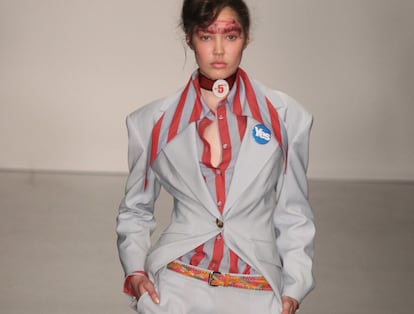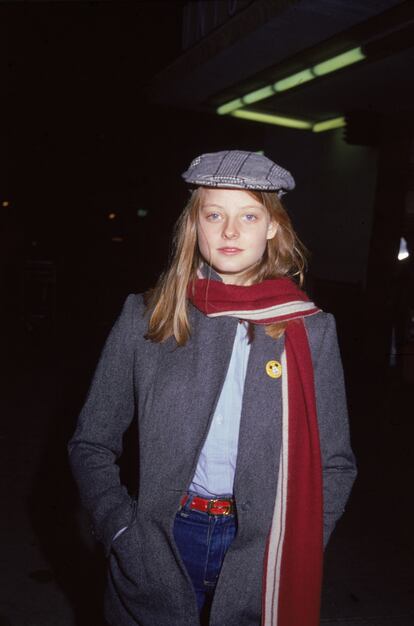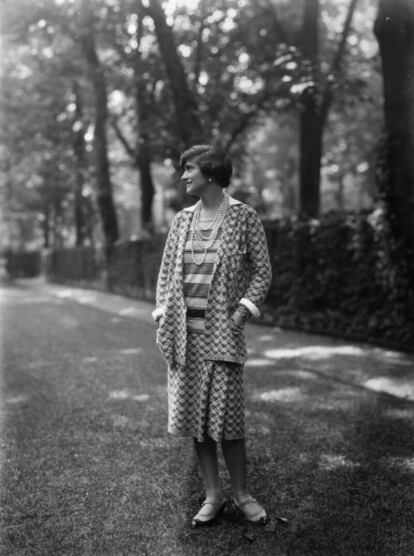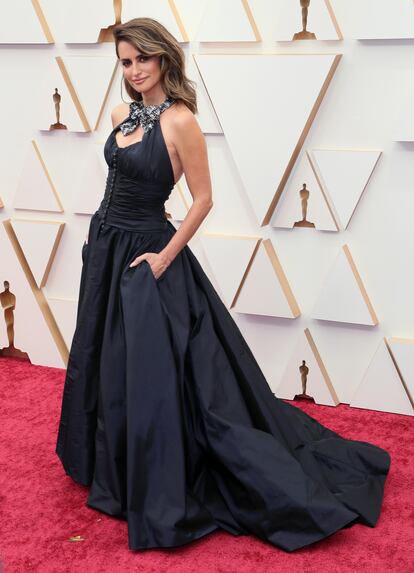It’s got pockets! Why this is still a battle cry for women
Why do men’s clothes have so many pockets and women’s so few? Spoiler: there’s no simple answer. It has taken Hannah Carlson an entire book to try to understand what’s behind this divide

Let’s start by doing an experiment. Yes, I’m talking to you, reader. Put your hands in your pockets. If you bought your clothes at a men’s store, this should be no problem. If you’re wearing women’s clothing, however, you’re likely to be in trouble. Unless you’re wearing pants (and sometimes even then), your pockets will be small, fake or simply nonexistent.
Why is this the case? Why do men’s clothes have so many pockets and our clothes so few? Spoiler: there’s no simple answer. It has taken Hannah Carlson an entire book — Pockets: An Intimate History of How We Keep Things Close — to try to understand what’s behind this divide.
She also tried to sum up the answer for EL PAÍS, putting the pocket gap down to two reasons: a) the various evolutions of men’s and women’s clothing and b) beliefs about who needs pockets.
The issue is as deep as the pockets we are longing for. And it’s not a new issue either: it predates the pocket activism we see today on social media with hashtags like #PocketInequality, #HerPocketsSuck, #wewantpockets, and #givemepocketsorgivemedeath.
In fact, it even predates the internet. In 1880, Carlson recounts, Harper’s Bazaar and The New York Times were already reporting that women had begun to mobilize for their right to enjoy pockets.

So who’s eliminating pockets from women’s clothes? Don’t worry, there is no global plot of powerful overlords deciding that women don’t deserve pockets. It can be blamed on several issues: the division of the functional and the beautiful (we lose out when we have to choose), the market (clothes without pockets are cheaper) and the fact that history cedes privileges to men and is slow to change.
Pockets are discreet, but they hold a complex history that brings together sociology, couture, politics, economics and ...secrets. Carlson points out that while zippers and buttons have functional purpose, pockets aren’t needed to put on or take off clothes. In other words, we don’t need them, but we want them.
The story of pockets is the story of our relationship with the objects we care about and how we keep them close to us. It is also the story of the need to hide them. Humans have always needed tools to get through their day-to-day lives. And we’ve always had to keep these tools close to us. Internal pockets are relatively recent.
For most of history, women carried what was necessary — which was little and often private — in belts or in small pouches that hung under dresses and were accessed through discreet openings. Women had few possessions of their own, and this was one of their few spaces of intimacy.
These pouches were common until the 18th century, when they began to be stolen. As a result, they were sewed into clothing. Each social class did it in their own way, with the fabric and ornamentation that they could afford. But they all had one thing in common: it was where they kept their most private, and in many cases, only possessions. When one of Jack the Ripper’s victims, Annie Chapman, was found dead, she had an envelope, pills, a small comb, and a piece of thick muslin that she hoped to pawn or sell in her pocket.
Keeping belongings close at hand has always depended on the design of clothing. The fashion for large, voluminous outfits made it easier to carry pouches sewn to the waistcoat, but as the fashion evolved towards more streamlined silhouettes, such as the Empire cut, it became more complicated.
It was at the beginning of the 20th century that the ridiculous became fashionable: tiny purses. It was the men who owned the money and who “did things.” They were the ones who deserved the pockets. Women had nothing to keep.
The 20th century came along and in 1916 Vogue wrote that pockets were “a new decorative element in design.” And along came Coco Chanel, with her hands stuffed in the pockets of her pants and jackets. Her pockets might have been small, but they were never fake.

World War II accelerated the adoption of garments from the men’s wardrobe and military uniforms into women’s clothing, which was given pockets. And there was no going back: something so seemingly simple made life easier.
Shortages during the war led to the creation of the Utility Cloth Scheme, a program that stipulated how to sew and dress without wasting material. The scheme stated that there should be no more than two pockets per dress.
The path started by Chanel had no turning back and Dior’s own disciple, Yves Saint Laurent, was clear: his world was another and the world was already a different place.
Nor did the fashion designer Cristóbal Balenciaga need to borrow anything from the men’s wardrobe: he sewed pockets how and where he wanted because he knew how to do it.
And then came the democratization of jeans, cargo pants and other garments that did include pockets because they came from menswear. That was followed by the second wave of feminism, and the need to take no more than necessary. A photo of Jackie Kennedy in a white mini-dress with her hands in her pockets shows us that this gesture is not just for protestors, it belongs to everyone, even the most bourgeois.
Let’s go back to the need to keep our possessions close to us. This poses another question: aren’t handbags helpful? After all, they allow us to carry the objects we need. The difference between pocket and purse lies in how close it is to the body. The pocket, Carlson states in that podcast, “is internal and secret and the purse can be stolen.”
She recalls that in 1954, Bonnie Cashin designed a skirt that had a purse sewed into it as if it were a pocket. “To steal the purse, you have to steal the girl,” the advertising material read.
The battle is not between handbag and pocket, but in how the industry “assumes we will carry handbags,” according to Carlson. In Pockets, the author recounts a well-known case in fashion history’s backstory, involving Diana Vreeland. In 1934, the fashion editor of Harper’s Bazaar had the idea of dedicating an entire issue to pockets, but had to abandon it because it was too dangerous: handbag advertisers might withdraw their support for the magazine.
Carlson also devotes many paragraphs in the book to the suffragettes, the standard-bearers for the fight for gender equality. These women — in addition to demanding the right to vote — also wanted to walk freely, unencumbered by handbags. The anti-suffragist propaganda used this to portray them as unattractive and manly. A book from the period. A Sketch of the Fair Sex in Politics (1898) depicts them in so-called “suffragette skirts,” with side pockets like those found in men’s clothing.
For Carlson, the crux of the inequality lies in the fact that only one gender is expected to require functional clothing, because only one gender is expected to use it and demand it. If women are just meant to look nice and sit still, why do we need to have and keep objects in our clothes?
Designer Moisés Nieto claims that the reason for the lack of pockets in women’s garments is also due to “a question of aesthetic tradition.” He points out that historically, women’s garment linked to couture and figure-hugging silhouette. “Pockets on fitted garments are often not flattering as there is a significant increase in fabric and stitching,” he explains. Nieto says that some clients ask him to remove the pockets from his dresses. It’s not because they are less modern or less free. They feel like they look better without them, and that makes them more feel more confident. It’s a paradox.

Contemporary women’s clothing does have pockets, and increasingly so, but many pockets are still small or fake. This tells us that aesthetics still trump functionality. Then there’s the economic reason: the clothes we wear are mass-produced, and every centimeter of fabric and every minute of sewing adds cost. The other reason is technical, pockets must be well-made, so that it does not deform the silhouette.
Mandy Fletcher is a woman who got tired of not finding women’s clothing with pockets and founded Pockets for Women, an online store that brings together garments with pockets from different brands. Carlson’s book mentions the results of an interesting study on pockets in men’s and women’s jeans from 20 major brands in the United States. It concluded that the average women’s pocket was 48% shorter and 6.5 flatter than men’s. Indeed, the pocket was so small, a woman couldn’t fit her hand inside, and in half of the cases, it wouldn’t fit a cellphone.
“It’s got pockets!” is an expression that is often exclaimed, as if it were the source of both joy and surprise. Like finding an unexpected $20-bill. Centuries after pockets were invented, women still feel shorthanded. As Carlson explains, the fashion industry doesn’t even bother to make up an excuse as to why women’s clothes have no pockets.
As Spanish actress Penélope Cruz showed last year on the red carpet, haute couture and pockets are not mutually exclusive. She made headlines with her Chanel gown, but hopefully, one day, an evening dress with pocket will not be news. Nor will we gleefully cry out “it has pockets!” — it will be commonplace. That day has not yet arrived.
Sign up for our weekly newsletter to get more English-language news coverage from EL PAÍS USA Edition
Tu suscripción se está usando en otro dispositivo
¿Quieres añadir otro usuario a tu suscripción?
Si continúas leyendo en este dispositivo, no se podrá leer en el otro.
FlechaTu suscripción se está usando en otro dispositivo y solo puedes acceder a EL PAÍS desde un dispositivo a la vez.
Si quieres compartir tu cuenta, cambia tu suscripción a la modalidad Premium, así podrás añadir otro usuario. Cada uno accederá con su propia cuenta de email, lo que os permitirá personalizar vuestra experiencia en EL PAÍS.
¿Tienes una suscripción de empresa? Accede aquí para contratar más cuentas.
En el caso de no saber quién está usando tu cuenta, te recomendamos cambiar tu contraseña aquí.
Si decides continuar compartiendo tu cuenta, este mensaje se mostrará en tu dispositivo y en el de la otra persona que está usando tu cuenta de forma indefinida, afectando a tu experiencia de lectura. Puedes consultar aquí los términos y condiciones de la suscripción digital.
More information
Últimas noticias
Sinaloa Cartel war is taking its toll on Los Chapitos
Venezuela hardens its ‘revolutionary state’ project amid pressure from Trump
Sydney Sweeney, the actress praised by Trump: ‘Women are up against what society wants them to be’
The Bolsonaro surname: An advantage or liability in Brazil’s 2026 presidential elections?
Most viewed
- Reinhard Genzel, Nobel laureate in physics: ‘One-minute videos will never give you the truth’
- Pablo Escobar’s hippos: A serious environmental problem, 40 years on
- Charles Dubouloz, mountaineering star, retires at 36 with a farewell tour inspired by Walter Bonatti
- Why we lost the habit of sleeping in two segments and how that changed our sense of time
- The fall of a prolific science journal exposes the billion-dollar profits of scientific publishing










































